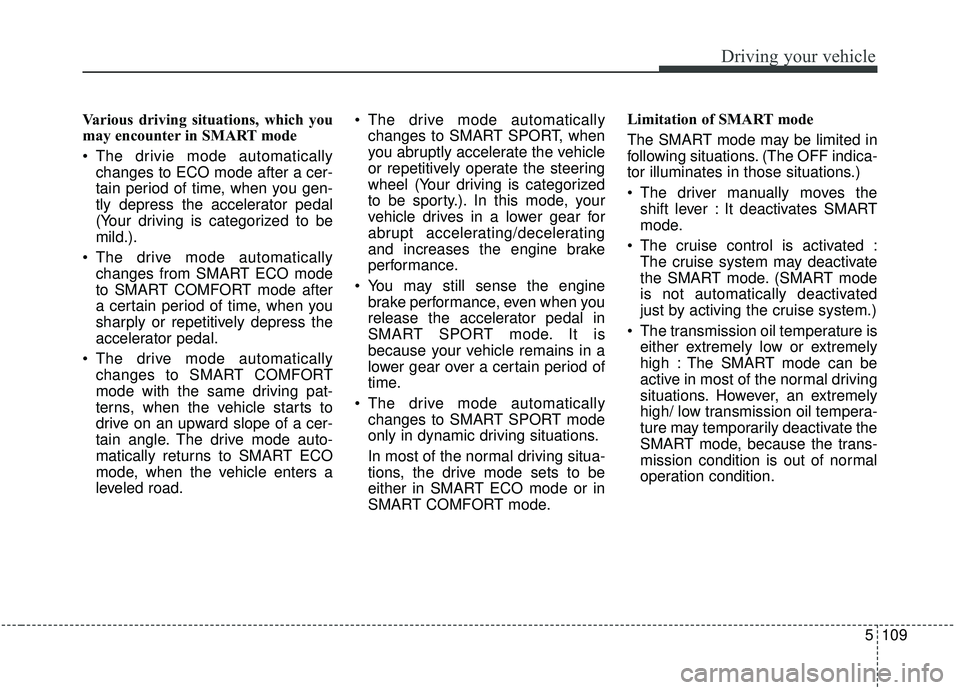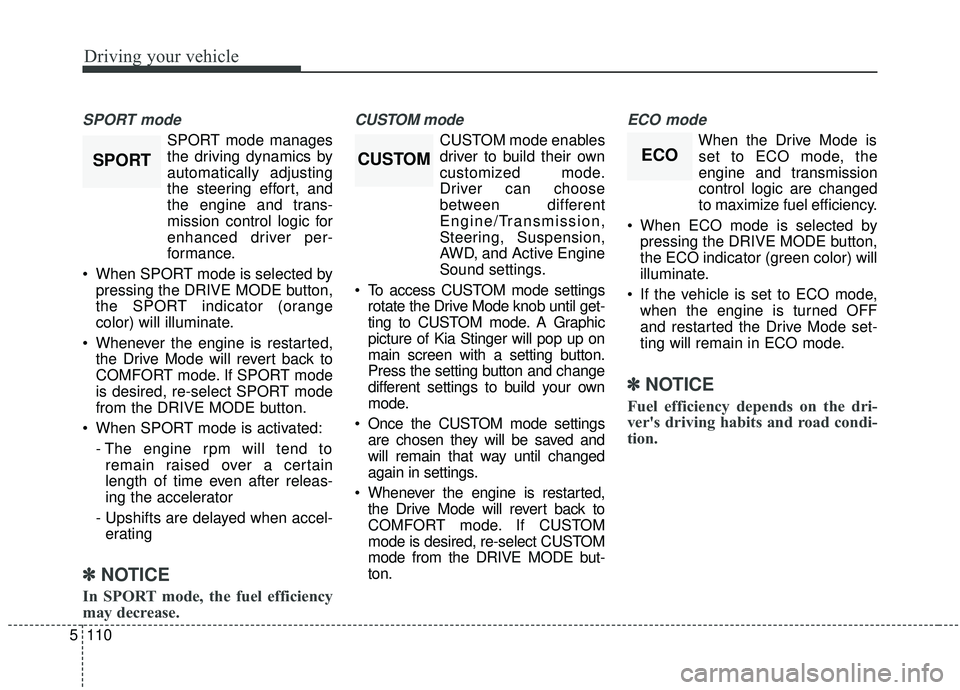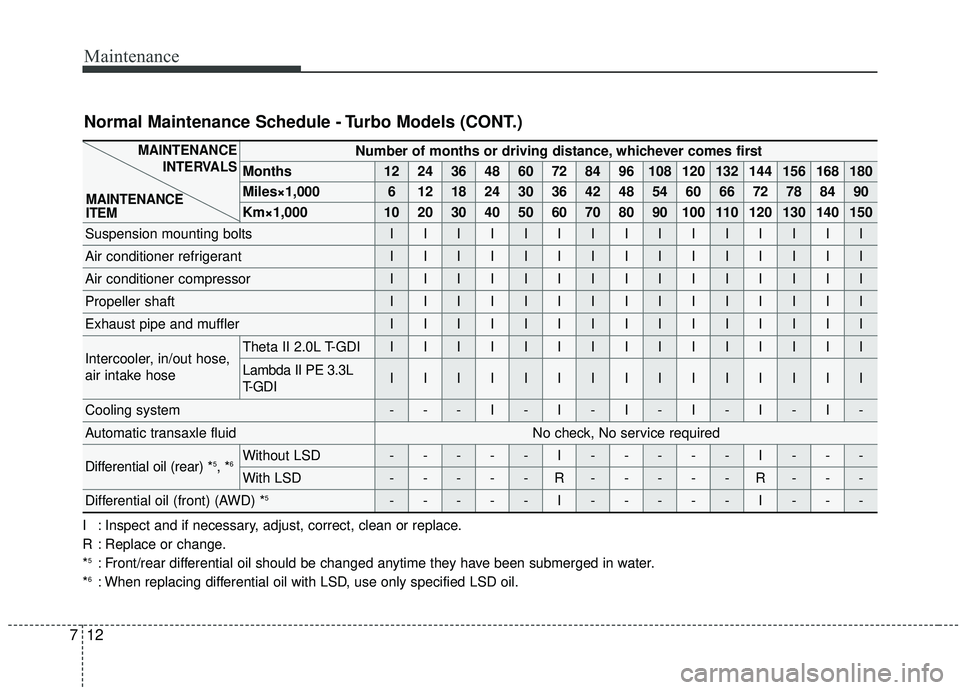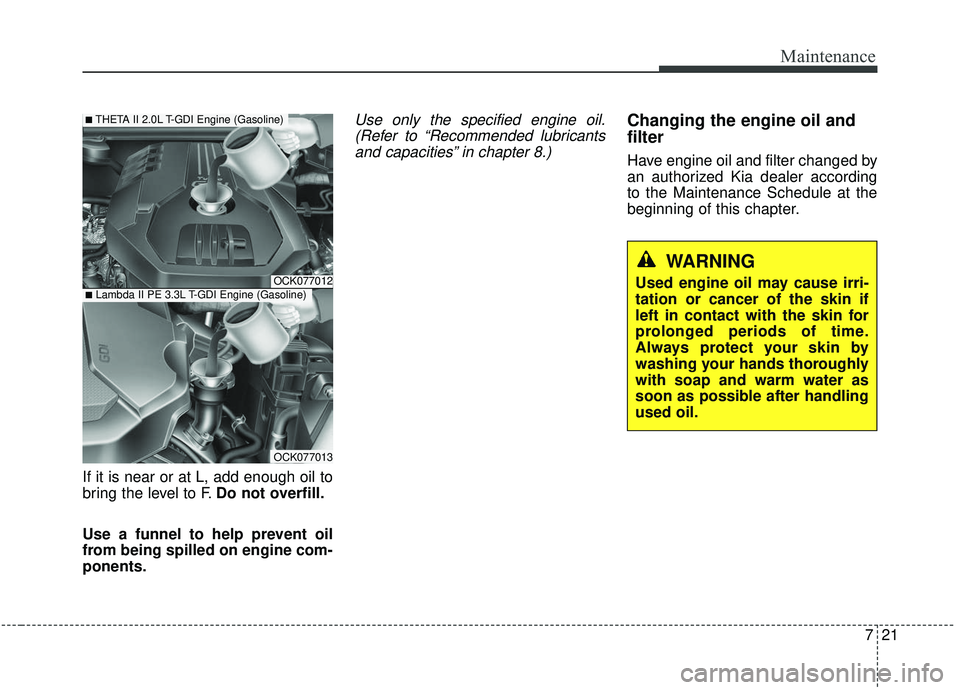2019 KIA STINGER change time
[x] Cancel search: change timePage 362 of 555

5109
Driving your vehicle
Various driving situations, which you
may encounter in SMART mode
The drivie mode automaticallychanges to ECO mode after a cer-
tain period of time, when you gen-
tly depress the accelerator pedal
(Your driving is categorized to be
mild.).
The drive mode automatically changes from SMART ECO mode
to SMART COMFORT mode after
a certain period of time, when you
sharply or repetitively depress the
accelerator pedal.
The drive mode automatically changes to SMART COMFORT
mode with the same driving pat-
terns, when the vehicle starts to
drive on an upward slope of a cer-
tain angle. The drive mode auto-
matically returns to SMART ECO
mode, when the vehicle enters a
leveled road. The drive mode automatically
changes to SMART SPORT, when
you abruptly accelerate the vehicle
or repetitively operate the steering
wheel (Your driving is categorized
to be sporty.). In this mode, your
vehicle drives in a lower gear for
abrupt accelerating/decelerating
and increases the engine brake
performance.
You may still sense the engine brake performance, even when you
release the accelerator pedal in
SMART SPORT mode. It is
because your vehicle remains in a
lower gear over a certain period of
time.
The drive mode automatically changes to SMART SPORT mode
only in dynamic driving situations.
In most of the normal driving situa-
tions, the drive mode sets to be
either in SMART ECO mode or in
SMART COMFORT mode. Limitation of SMART mode
The SMART mode may be limited in
following situations. (The OFF indica-
tor illuminates in those situations.)
The driver manually moves the
shift lever : It deactivates SMART
mode.
The cruise control is activated : The cruise system may deactivate
the SMART mode. (SMART mode
is not automatically deactivated
just by activing the cruise system.)
The transmission oil temperature is either extremely low or extremely
high : The SMART mode can be
active in most of the normal driving
situations. However, an extremely
high/ low transmission oil tempera-
ture may temporarily deactivate the
SMART mode, because the trans-
mission condition is out of normal
operation condition.
Page 363 of 555

Driving your vehicle
110
5
SPORT mode
SPORT mode manages
the driving dynamics by
automatically adjusting
the steering effort, and
the engine and trans-
mission control logic for
enhanced driver per-
formance.
When SPORT mode is selected by pressing the DRIVE MODE button,
the SPORT indicator (orange
color) will illuminate.
Whenever the engine is restarted, the Drive Mode will revert back to
COMFORT mode. If SPORT mode
is desired, re-select SPORT mode
from the DRIVE MODE button.
When SPORT mode is activated: - The engine rpm will tend toremain raised over a certain
length of time even after releas-
ing the accelerator
- Upshifts are delayed when accel- erating
✽ ✽ NOTICE
In SPORT mode, the fuel efficiency
may decrease.
CUSTOM mode
CUSTOM mode enables
driver to build their own
customized mode.
Driver can choose
between different
Engine/Transmission,
Steering, Suspension,
AWD, and Active Engine
Sound settings.
To access CUSTOM mode settings rotate the Drive Mode knob until get-
ting to CUSTOM mode. A Graphic
picture of Kia Stinger will pop up on
main screen with a setting button.
Press the setting button and change
different settings to build your own
mode.
Once the CUSTOM mode settings are chosen they will be saved and
will remain that way until changed
again in settings.
Whenever the engine is restarted, the Drive Mode will revert back to
COMFORT mode. If CUSTOM
mode is desired, re-select CUSTOM
mode from the DRIVE MODE but-
ton.
ECO mode
When the Drive Mode isset to ECO mode, the
engine and transmission
control logic are changed
to maximize fuel efficiency.
When ECO mode is selected by pressing the DRIVE MODE button,
the ECO indicator (green color) will
illuminate.
If the vehicle is set to ECO mode, when the engine is turned OFF
and restarted the Drive Mode set-
ting will remain in ECO mode.
✽ ✽ NOTICE
Fuel efficiency depends on the dri-
ver's driving habits and road condi-
tion.
ECOSPORTCUSTOM
Page 441 of 555

Maintenance
10
7
Normal Maintenance Schedule - Turbo Models
The following maintenance services must be performed to ensure good emission control and performance.
Keep receipts for all vehicle emission services to protect your warranty. Where both mileage and time are shown, the
frequency of service is determined by whichever occurs first.
Number of months or driving distance, whichever comes first
Months1224364860728496108120132144156168180
Miles×1,00061218243036424854606672788490
Km×1,000102030405060708090100110120130140150
Drive belts *1At first, inspect at 100,000 km (60,000 miles) or 72 months,
after that, inspect every 20,000 km (12,000 miles) or 24 months
Engine oil and engine oil
filterTheta II 2.0L T-GDIRRRRRRRRRRRRRRR
Lambda II PE 3.3L
T- G D IRRRRRRRRRRRRRRR
Fuel additives *2Add every 10,000 km (6,000 miles) or 12 months
Air cleaner filter-I-R-I-R-I-R-I-
Spark plugs
Theta II 2.0L T-GDIReplace every 70,000 km (42,000 miles)
Lambda II PE 3.3L
T- G D IReplace every 70,000 km (42,000 miles)
MAINTENANCE
INTERVALS
MAINTENANCE
ITEM
I : Inspect and if necessary, adjust, correct, clean or replace.
R : Replace or change.
*
1: The drive belt should be replaced when cracks occur or tension is reduced.
*2: If TOP TIER Detergent Gasoline is not available, one bottle of additive is recommended. Additives are available from your authorized Kia dealer along with information on how to use them. Do not mix other additives.
Page 443 of 555

Maintenance
12
7
Number of months or driving distance, whichever comes first
Months1224364860728496108120132144156168180
Miles×1,00061218243036424854606672788490
Km×1,000102030405060708090100110120130140150
Suspension mounting boltsIIIIIIIIIIIIIII
Air conditioner refrigerantIIIIIIIIIIIIIII
Air conditioner compressorIIIIIIIIIIIIIII
Propeller shaftIIIIIIIIIIIIIII
Exhaust pipe and mufflerIIIIIIIIIIIIIII
Intercooler, in/out hose,
air intake hoseTheta II 2.0L T-GDIIIIIIIIIIIIIIII
Lambda II PE 3.3L
T- G D IIIIIIIIIIIIIIII
Cooling system---I-I-I-I-I-I-
Automatic transaxle fluidNo check, No service required
Differential oil (rear) *5, *6Without LSD-----I-----I---
With LSD-----R-----R---
Differential oil (front) (AWD) *5-----I-----I---
MAINTENANCE
INTERVALS
MAINTENANCE
ITEM
Normal Maintenance Schedule - Turbo Models (CONT.)
I : Inspect and if necessary, adjust, correct, clean or replace.
R : Replace or change.
*
5: Front/rear differential oil should be changed anytime they have been submerged in water.
*6: When replacing differential oil with LSD, use only specified LSD oil.
Page 447 of 555

Maintenance
16
7
EXPLANATION OF SCHEDULED MAINTENANCE ITEMS
Engine oil and filter
The engine oil and filter should be
changed at the intervals specified in
the maintenance schedule. If the
vehicle is being driven in severe con-
ditions, more frequent oil and filter
changes are required.
Drive belts
Inspect all drive belts for evidence of
cuts, cracks, excessive wear or oil
saturation and replace if necessary.
Drive belts should be checked peri-
odically for proper tension and
adjusted as necessary.
Fuel filter (for gasoline)
Kia gasoline vehicle is equipped a
lifetime fuel filter that integrated with
the fuel tank. Regular maintenance
or replacement is not needed but
depends on fuel quality. If there are
some important safety matters like
fuel flow restriction, surging, loss of
power, hard starting problem etc, fuel
filter inspection or replace is needed.
The fuel filter be Inspected or
replaced by an authorized Kia dealer.
Fuel lines, fuel hoses and con-
nections
Check the fuel lines, fuel hoses and
connections for leakage and dam-
age. Have an authorized Kia dealer
replace any damaged or leaking
parts immediately.
Vapor hose and fuel filler cap
The vapor hose and fuel filler cap
should be inspected at those inter-
vals specified in the maintenance
schedule. Make sure that a new
vapor hose or fuel filler cap is cor-
rectly replaced.
Page 452 of 555

721
Maintenance
If it is near or at L, add enough oil to
bring the level to F.Do not overfill.
Use a funnel to help prevent oil
from being spilled on engine com-
ponents.
Use only the specified engine oil. (Refer to “Recommended lubricantsand capacities” in chapter 8.)Changing the engine oil and
filter
Have engine oil and filter changed by
an authorized Kia dealer according
to the Maintenance Schedule at the
beginning of this chapter.
OCK077012
OCK077013
■THETA II 2.0L T-GDI Engine (Gasoline)
■Lambda II PE 3.3L T-GDI Engine (Gasoline)
WARNING
Used engine oil may cause irri-
tation or cancer of the skin if
left in contact with the skin for
prolonged periods of time.
Always protect your skin by
washing your hands thoroughly
with soap and warm water as
soon as possible after handling
used oil.
Page 542 of 555

88
Specifications & Consumer information
Lubricant VolumeClassification
Rear differential oil (without LSD)
(Theta II 2.0L T-GDI) *31.2 l (1.27 US qt.)HYPOID GEAR OIL API GL-5 SAE 75W/85
(SK HK SYN GEAR OIL 75W85)
Rear differential oil (without LSD)
(Lambda II PE 3.3L T-GDI) *31.3 l (1.37 US qt.)
Rear differential oil (with LSD)
(Theta II 2.0L T-GDI) *3*41.3 l (1.37 US qt.)HYPOID GEAR OIL API GL-5 SAE 75W/85
(SK HK JL SYN LSD GEAR OIL 75W85 PLUS)
Rear differential oil (with LSD)
(Lambda II PE 3.3L T-GDI) *3*41.4 l (1.48 US qt.)
Front differential oil *3
(AWD)0.7 l (0.74 US qt.)HYPOID GEAR OIL API GL-5 SAE 75W/85
(SK HK SYN GEAR OIL 75W85)
Transfer oil
(AWD)Gear/ Clutch0.57 l (0.60 US qt.)
SHELL TF 0870B
Actuator0.25 l (0.26 US qt.)
FuelGasoline Engine60 l (63.36 US qt.)Refer to Fuel requirements in chapter 1
*1: Refer to the recommended SAE viscosity numbers on the next page.
*2: Engine oils labeled Energy Conserving Oil are now available. Along with other additional benefits, they contribute to fuel economy by reducing the amount of fuel necessary to overcome engine friction. Often, these improvements are difficult to measure in everyday driving, but in a year’s
time, they can offer significant cost and energy savings.
*
3: Regardless of oil change intervals, replace oil immediately if Rear-Differential or Front-Differential is submerged.
*4: Be sure to inject oil for exclusive use of LSD when replacing Rear Differential (for LSD) Oil.
Page 552 of 555

I7
Index
Map lamp (LED type) bulb replacement . . . . . . . . . 7-89
Position lamp + DRL (LED type) bulb replacement (Headlamp Type A) . . . . . . . . . . . . . . . . . . . . . . . . 7-81
Rear side marker (LED type) bulb replacement . . . 7-84
Rear turn signal lamp (bulb type) bulb replacement . 7-85
Rear turn signal lamp (LED type) bulb replacement . . 7-85
Room lamp (LED type) bulb replacement . . . . . . . . 7-90
Side marker bulb replacement (Headlamp Type A) . 7-81
Side repeater lamp (LED type) bulb replacement . . 7-89
Stop and tail lamp (LED type) bulb replacement . . 7-84
Vanity mirror lamp (LED type) bulb replacement . . 7-90
Lighting. . . . . . . . . . . . . . . . . . . . . . . . . . . . . . . . . . . . \
4-114 Battery saver function . . . . . . . . . . . . . . . . . . . . . . 4-114
Check headlight . . . . . . . . . . . . . . . . . . . . . . . . . . . 4-120
Daytime running light . . . . . . . . . . . . . . . . . . . . . . 4-114
Dynamic Bending Light (DBL) . . . . . . . . . . . . . . . 4-121
Headlight leveling device . . . . . . . . . . . . . . . . . . . . 4-120
High beam assist . . . . . . . . . . . . . . . . . . . . . . . . . . 4-117
High beam operation . . . . . . . . . . . . . . . . . . . . . . . 4-116
Lighting control . . . . . . . . . . . . . . . . . . . . . . . . . . . 4-114
Turn signals and lane change signals . . . . . . . . . . . 4-119
Limited Slip Differential (LSD) . . . . . . . . . . . . . . . . . . 5-41
Luggage volume . . . . . . . . . . . . . . . . . . . . . . . . . . . . . . . 8-6 Maintenance services . . . . . . . . . . . . . . . . . . . . . . . . . . . 7-4
Owner maintenance precautions . . . . . . . . . . . . . . . . 7-5
Owner’s responsibility . . . . . . . . . . . . . . . . . . . . . . . . 7-4
Mirrors . . . . . . . . . . . . . . . . . . . . . . . . . . . . . . . . . . . . \
. 4-55 Inside rearview mirror . . . . . . . . . . . . . . . . . . . . . . . 4-55
Outside rearview mirror . . . . . . . . . . . . . . . . . . . . . . 4-64
Owner maintenance . . . . . . . . . . . . . . . . . . . . . . . . . . . . 7-7 Owner maintenance schedule. . . . . . . . . . . . . . . . . . . 7-7
Parking brake . . . . . . . . . . . . . . . . . . . . . . . . . . . . . . . . 7-28 Checking the parking brake . . . . . . . . . . . . . . . . . . . 7-28
Parking distance warning - reverse . . . . . . . . . . . . . . . 4-107 Non-operational conditions of parking distance warning-reverse . . . . . . . . . . . . . . . . . . . . . . . . . . 4-108
Operation of the parking distance warning-reverse . 4-107
Parking distance warning-reverse precautions . . . . 4-109
Self-diagnosis . . . . . . . . . . . . . . . . . . . . . . . . . . . . . 4-110M
O
P